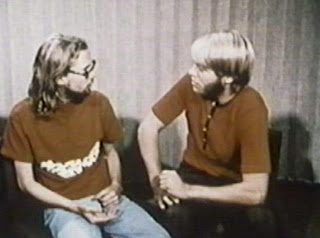



This blog is open to all practitioners and theorists of 'experimental communities.' A core constituent of this collective are members of the interdisciplinary seminar with the same title taught by Pedro Lasch at Duke University, as well as various political and cultural networks including 16 Beaver Group (NY). Anyone can comment on posted materials. To post something, please email experimentalcommunities@gmail.com






Beyond Freedom and Dignity is a book written by American psychologist B. F. Skinner and first published in 1971. The book argues that entrenched belief in free will and the moral autonomy of the individual (which Skinner referred to as "dignity") hinders the prospect of using scientific methods to modify behavior for the purpose of building a happier and better organized society.
Beyond Freedom and Dignity may be summarized as an attempt to promote Skinner's philosophy of science, the technology of human behavior, his conception of determinism, and what Skinner calls 'cultural engineering'.
http://en.wikipedia.org/wiki/Beyond_Freedom_and_Dignity#A_Technology_of_Behavior

"Walden Two (1948) is a utopian novel by behavioral psychologist B. F. Skinner, describing a small, thousand-person, rural planned community of happy, productive, and creative people. Planners and Managers govern a community requiring only four daily hours of work from each person, and that promotes the arts and applied scientific research. The community subscribe to a code of conduct based upon, and supported by, a behaviourism resembling that of author Skinner.
Walden Two challenges contemporary U.S. social conventions such as the value of modern education, the effectiveness of university professors, excessive work volume, and posits a planned economy, critical of inefficient capitalism. The community's government is not democratic; children are reared communally, outside the nuclear family, and loyalty to community, instead of parents, is encouraged. Childbearing is encouraged as soon as possible, in pursuit of a great growth policy, and eugenics are considered in possibly creating a Golden Age.
Walden Two is controversial for its rejection of democracy as effective government, viable socialist economy, an atheist society, the narrow range of available emotional expression, its appeal to dictators and to emulators of T.E. Frazier, the emotionally unstable protagonist. "
The plot
"Six visitors arrive at a thousand-person community then ten years old. A decade earlier, T.E. Frazier wrote an article asking people join him in founding a community based on philosopher H. D. Thoreau's ideas. Two soldiers, returned from the war, seek Frazier, and enlist Professor Burris's help; he finds and communicates with Frazier, then joins the visit to the community. Prof. Burris invites Prof. Augustine Castle, and, with the two soldiers, Rogers and Steve Jamnick, and their girlfriends, Mary Grove and Barbara Macklin, they visit Walden Two.
The story concerns the arguments among founder Frazier and Prof. Castle and Prof. Burris, which exposit the reasons for the community's structure, its past and its future.At story's end, one couple stay in the community, while the other visitors leave, however, in a sudden change of heart, Prof. Burris quits his university post and returns to the rural community."
Creating a "Walden Two in real life are detailed in Hilke Kuhlmann's Living Walden Two[10] and in Daniel W. Bjork's B.F.Skinner."
"Some of them include:

http://en.wikipedia.org/wiki/Walden_Two
http://www.press.uillinois.edu/books/images/9780252029622.jpg
http://www.coverbrowser.com/image/bestselling-sci-fi-fantasy-2006/1128-1.jpg




Project Chanology is a widespread protest of the
Protests typically question the status of the
The following video outlines some of their rules to follow when protesting: http://www.youtube.com/watch?v=-063clxiB8I
http://www.anonymousresources.com/protesting
Protest Guidelines
Be aware that you are taking a risk by protesting. Note a huge risk - this isn't the Mafia, after all - but the danger is real. In the past, protesters have been followed, harassed, or assaulted. Scientology is dangerous; that's why we're protesting. But have a little courage, and follow these guidelines, and you'll be fine.
Stay calm. Don't let yourself be baited into anger. Just relax. You have nothing to gain by screaming, and everything to gain by staying calm.
Cover your face. A Guy Fawkes mask is preferred (see section below on masks) but the important thing is just to conceal your identity. We're called Anonymous for a reason.
Cooperate with law enforcement and city officials. If you're new, someone else will probably be notifying city officials of the protest, you don't need to worry about that. But if a police officer tells you to do something, comply as best you can. Anonymous has a good relationship with law enforcement as a general rule; let's keep it that way.
No violence or weapons. This goes for fake weapons too.
Don't do anything stupid. This includes drinking alcohol (before or during), violence, vandalism, obscenities, hate speech, messing with cops, and going into the Scientology building.
Never be alone. Strength in numbers.
Think about what you'll wear. Generally there is no dress code for protests, but dressing more formally (as in a suit and tie) does make the public - and Scientologists - take you more seriously. Also consider bringing a change of clothes so as to throw off pursuit once the protest ends.
Bring water.
Know how to contact law enforcement if necessary. For many protests, police officers will be standing nearby. It's also a good idea to have the local police on speed-dial.
When you leave, watch for pursuit. Scientologists do sometimes follow protesters back to their cars. If you think you are being followed, do not go to your car. Notify law enforcement.
From the Encyclopedia Dramatica:
Anonymous is devoid of humanity, morality, pity, and mercy.
Anonymous works as one, because none of us are as cruel as all of us.
Anonymous cannot be harmed, no matter how many Anonymous may fall in battle.
Anonymous doesn't fall in battle, anyway.
Anonymous only undertakes Serious Business.
Anonymous is everyone
Anonymous is everywhere.
Anonymous cannot be out-numbered.
Anonymous is a hydra, constantly moving, constantly changing. Remove one head, and nine replace it.
Anonymous reinforces its ranks exponentially at need.
Anonymous has no weakness or flaw.
Anonymous exploits all weaknesses and flaws.
Anonymous doesn't have a family or friends.
Anonymous is your family and friends.
Anonymous is not your friend.
Anonymous is not your personal army.
Anonymous is in control at all times.
Anonymous does not accept failure, Anonymous delivers.
Anonymous has no identity.
Anonymous cannot be betrayed.
Anonymous does it for the lulz.
Anonymous is humanity.
Anonymous are created as equals.
Anonymous is a choice.
Anonymous is an unstoppable force.
If Anonymous must have a name, his name is David.
Anonymous obeys the Code.
Anonymous is Legion.
Anonymous does not forgive.
Anonymous does not forget.
Also:
Anonymous, in addition to being responsible for 85% of all quotes ever made, is the source of 91% of all internet truth and justice and 32.33, repeating of course, daily dosage of Vitamin /b/. Anonymous is void of human restraints, such as pity and mercy. Those who perform reckless actions or oppose Anonymous will be eliminated. Failure is not tolerated. Enemies are to be dealt with swiftly and efficiently. Anonymous must work as one. No single Anonymous knows everything. Anonymous is everyone and noone. You are. I am. Everyone is. Anonymous is humanity when the gloves come off.
Anonymous is not a person, nor is it a group, movement or cause: Anonymous is a collective of people with too much time on their hands, a commune of human thought and useless imagery. A gathering of sheep and fools, assholes and trolls, and normal everyday netizens. An anonymous collective, left to its own devices, quickly builds its own society out of rage and hate. Anonymous can be anyone from well-meaning college kids with highly idiosyncratic senses of humor trying to save people from Scientology, to devious nihilist hackers, to thirteen year old boys who speak entirely in in-jokes on an endless quest for porn.
Anonymous is not so much unlike other web communities, it has in-jokes, culture, extended debates, etc, just like everyone else. Well, anyone stupid enough to join a web community. The difference, and the reason they visit other communities is that Anonymous have a need to be harassed by "nannying" moderators. They hate being denied late night sleepovers. Here, there isn't anyone to do that - yet long and productive edit wars spring up at about the rate you'd never tolerate elsewhere, on topics you'd never believe. They have no leader, no pretentious douchebag president or group thereof to set in stone what Anonymous is and is not about. This makes them impossible to control or organize. Not really a collective at all - more like a stampede of coked-up lemmings. They don't dare to lead for will but rather break the "bridge" instead. And since it's all made out of Legos, fuck it.
Starting as an in-joke itself, "Anonymous" is the name assigned to a poster who does not enter text in the [Name] field on chan imageboards. Anonymous is not a single person, but rather, represents the collective whole of the internet.
As individuals, they can be intelligent, rational, emotional and empathetic. As a mass, a group, they are devoid of humanity and mercy. Never before in the history of humanity has there once been such a morass, a terrible network of the peer-pressure that forces people to become one, become evil. Welcome to the soulless mass of blunt immorality known only as the Internet.
Anonymous are the Monsters from the